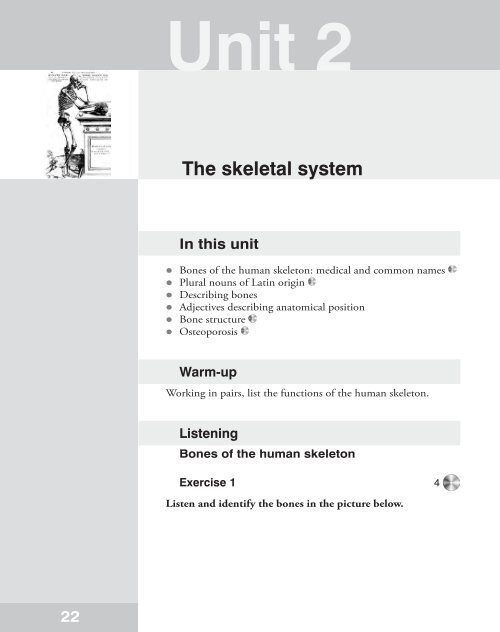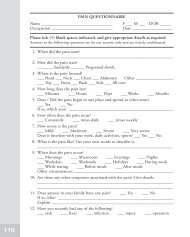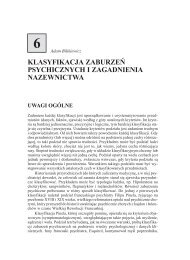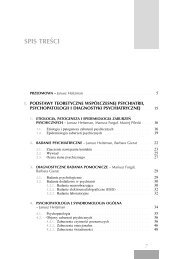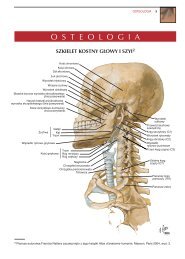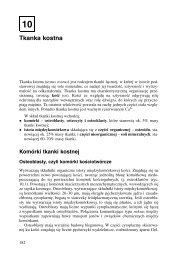Vocabulary - Wydawnictwo Lekarskie PZWL
Vocabulary - Wydawnictwo Lekarskie PZWL
Vocabulary - Wydawnictwo Lekarskie PZWL
Create successful ePaper yourself
Turn your PDF publications into a flip-book with our unique Google optimized e-Paper software.
22<br />
Unit 2<br />
The skeletal system<br />
In this unit<br />
l Bones of the human skeleton: medical and common names<br />
l Plural nouns of Latin origin<br />
l Describing bones<br />
l Adjectives describing anatomical position<br />
l Bone structure<br />
l Osteoporosis<br />
Warm-up<br />
Working in pairs, list the functions of the human skeleton.<br />
Listening<br />
Bones of the human skeleton<br />
Exercise 1 4<br />
Listen and identify the bones in the picture below.
Atlas<br />
Axis<br />
7 cervical vertebrae<br />
12 thoracic vertebrae<br />
5 lumbar vertebrae<br />
Tail bone (coccyx)<br />
Wrist bones (carpals)<br />
Palm bones (metacarpals)<br />
Finger bones (phalanges)<br />
Skull (cranium)<br />
Jaw bone (mandible)<br />
Ankle bone<br />
(talus)<br />
Heel bone (calcaneus)<br />
12 pairs of ribs<br />
Tarsals<br />
Foot bones (metatarsals)<br />
Toe bones (phalanges)<br />
Collarbone (clavicle)<br />
Shoulder blade (scapula)<br />
Breastbone (sternum)<br />
Humerus<br />
Ulna<br />
Radius<br />
Hip bone (os coxae)<br />
Sacrum<br />
Thigh bone (femur)<br />
Kneecap (patella)<br />
Shin bone (tibia)<br />
Calf bone (fibula)<br />
23
24<br />
NOTE<br />
Over ninety per cent (90%) of technical terms in anatomy, surgery,<br />
clinical medicine and laboratory medicine are of Greek, Latin and<br />
Greco-Latin origin. Many of them have their English equivalents.<br />
The technical terms are used in the literature and between health<br />
professionals, but when you talk to patients, the rule is ‘English,<br />
please!’<br />
Exercise 2 4<br />
Listen and repeat technical and common names of the bones.<br />
Follow them in the picture.<br />
<strong>Vocabulary</strong> building<br />
Exercise 3<br />
Complete the table giving medical and common names of the<br />
following bones. How many can you name without referring<br />
to the picture in Exercise 1? Can you remember more medical<br />
terms or more common names?<br />
Kość Medical English name Common name<br />
czaszka<br />
kość krzyżowa<br />
kość łokciowa<br />
kość piszczelowa<br />
kość promieniowa<br />
kość ramienna<br />
kość strzałkowa<br />
kość udowa<br />
kości śródstopia<br />
kości stępu<br />
kręgosłup
łopatka<br />
mostek<br />
obojczyk<br />
paliczki<br />
rzepka<br />
żebra<br />
żuchwa<br />
Exercise 4<br />
Read the description of the human skeleton adding the missing<br />
names of the bones, either common or technical.<br />
The skeleton of an adult human is formed by 206 bones. The<br />
bones are organised into two groups known as the axial skeleton<br />
and the appendicular skeleton.<br />
The axial skeleton includes the skull and the bones of the trunk<br />
(the vertebral column, rib cage and sternum, or 1……...…...). The skull is made up of eight bones which form the cranium and<br />
fourteen bones which make the skeleton of the face. The only<br />
movable bone is the 2….……..…. or lower jaw bone. The spinal<br />
column consists of 33 vertebrae. The rib cage (thoracic cage) is<br />
formed of twelve pairs of ribs with the top seven pairs of ribs<br />
attached directly to the 3………………. and known as true ribs.<br />
The next five pairs are called false ribs because they are not joined<br />
to the sternum directly. The 8th , 9th and 10th ribs are fused with the<br />
rib above, but the 11th and 12th , called floating ribs, are unattached<br />
in front.<br />
The appendicular skeleton consists of the bones of extremities<br />
( 4……………..….) and the bones that attach them to the axial<br />
skeleton.<br />
The shoulder girdle is formed by the 5………………. or<br />
collarbones and the scapulae, or 6……..…… . It supports the<br />
upper limb attaching its skeleton to the axial skeleton. The bone of<br />
the upper arm is called the 7………….…. . The 8……………….. is the outer and shorter bone of the forearm. The other bone, inner<br />
and longer, is the 9…………..…… The wrist contains eight bones<br />
called the 10…………….., each hand is formed of five bones<br />
<strong>Vocabulary</strong><br />
axial skeleton kościec osiowy<br />
(głowy i tułowia)<br />
appendicular skeleton kościec<br />
kończyn<br />
thoracic cage (rib cage) klatka<br />
piersiowa<br />
extremities (limbs) kończyny<br />
shoulder girdle obręcz<br />
kończyny górnej<br />
25
<strong>Vocabulary</strong><br />
pelvic girdle obręcz kończyny<br />
dolnej<br />
flexible giętki, elastyczny<br />
tough twardy, wytrzymały<br />
framework szkielet<br />
brain mózg<br />
heart serce<br />
lungs płuca<br />
spinal cord rdzeń kręgowy<br />
viscus, pl. viscera narząd<br />
trzewny, trzewie<br />
bone marrow szpik kostny<br />
bloodstream krwiobieg<br />
26<br />
( 11 ……………….) and each set of 12 ……….….. has 14 bones<br />
known as phalanges.<br />
The pelvic girdle consists of the right hip bone and the left<br />
hip bone and connects the lower limbs to the axial skeleton. Each<br />
lower limb has four bones. These are the femur, or 13 ………….…..<br />
bone, the 14 ….............….., or kneecap, and two bones in the lower<br />
leg which are the tibia, or 15 …..........….. bone and the fibula. The<br />
ankle contains seven bones ( 16 …………….…..), the foot has five<br />
bones ( 17 …………..….) and each set of 18 ….................... contains<br />
14 bones.<br />
The bones are connected by joints (articulations) with tough<br />
bands of white fibrous connective tissue known as ligaments.<br />
Tendons, which are fibrous cords or bands attach the skeletal<br />
muscles to the bones.<br />
The skeleton, which is strong, movable and flexible, forms<br />
the framework of the body and is responsible for movement<br />
(locomotion). Its parts also protect soft tissues and internal organs.<br />
The skull protects the brain, the rib cage protects the heart and the<br />
lungs, the vertebral column protects the spinal cord and the pelvic<br />
bones give some protection to the viscera. In the bone marrow<br />
within bones blood cells are produced. The bones store calcium<br />
and other minerals which are released into the bloodstream when<br />
needed.<br />
Exercise 5<br />
In the text above, what bones do these numbers refer to?<br />
Example: 1. There is only one (1) movable bone in the facial skeleton.<br />
It is the mandible, or lower jaw.<br />
2. 2 7. 8<br />
3. 3 8. 12<br />
4. 4 9. 14<br />
5. 5 10. 33<br />
6. 7 11. 206<br />
NOTE:<br />
With many foreign nouns the original plural is used, with some<br />
it is either the original plural or the more recently introduced<br />
anglicised plural, e.g. one scapula but two scapulae or two scapulas.
Listening<br />
Exercise 6 5<br />
Listen and repeat the names of the bones with their plurals.<br />
singular original plural regular English plural<br />
calcaneus calcanei<br />
fibula fibulae fibulas<br />
humerus humeri<br />
phalanx phalanges<br />
radius radii<br />
scapula scapulae scapulas<br />
sternum sterna<br />
tibia tibiae tibias<br />
ulna ulnae ulnas<br />
vertebrae vertebrae<br />
<strong>Vocabulary</strong> building<br />
Exercise 7<br />
Complete the table with appropriate nouns or adjectives.<br />
Noun Adjective<br />
axis<br />
bony<br />
cranial<br />
ulna<br />
tibial<br />
radial<br />
humerus<br />
femoral<br />
vertebra<br />
clavicular<br />
sternum<br />
patella<br />
rib costal<br />
coccygeal<br />
sacral<br />
27
28<br />
Exercise 8<br />
Complete the table with the names of the bones under<br />
appropriate heading. You may add your own examples.<br />
calcaneus metacarpals femur humerus patella<br />
sternum tarsal vertebra facial bones vertebrae<br />
metatarsals radius scapula carpal bones tibia<br />
Bone(s)<br />
short flat long sesamoid triangular irregular<br />
Exercise 9<br />
Identify the bones described below.<br />
1. A paired long slender curved bone which forms the front part<br />
of the shoulder girdle is called the clavicle, or collar bone.<br />
2. A flat bone which forms the front part of the thoracic cage is<br />
known as ………………, or ………… .<br />
3. The bone of the upper arm is named ………………… .<br />
4. The outer and shorter of the two bones of the forearm is<br />
referred to as ……………… .<br />
5. The small bone situated in front of the knee is called<br />
………….., or ………………… .<br />
6. The larger of the two bones of the lower leg is known as<br />
……………., or …………… .<br />
7. The eight bones which make up the wrist are named<br />
……………… .<br />
8. The five bones in the hand between the fingers and the wrist<br />
are referred to as …………. .<br />
9. Bones in fingers and toes are called ………………………… .<br />
10. One of the ring-shaped bones which form the spine is called<br />
…………… .<br />
11. The longest, and the largest and strongest bone is the body is<br />
named …………., or ……… .
Exercise 10<br />
Make your own descriptions of these bones. Work in pairs.<br />
Take turns reading the descriptions to a partner, whose task is<br />
to guess what bone you have described.<br />
ulna<br />
fibula<br />
calcaneus<br />
metatarsals<br />
humerus<br />
patella<br />
Adjectives describing anatomical position<br />
Exercise 11<br />
The adjectives below are used to describe the relative position of<br />
the body parts. Match each adjective (1–10) with its meaning<br />
(a–j).<br />
29
30<br />
1. superior a. inside the body, further from the skin<br />
2. inferior b. above another part, higher up than another<br />
part, closer to the head<br />
3. anterior c. at the back, behind<br />
4. posterior d. in front<br />
5. proximal e. below another part, lower down, closer to<br />
the feet<br />
6. distal f. closer to a point of attachment<br />
7. medial g. towards or nearer to the midline of the<br />
body<br />
8. lateral h. towards or nearer the side<br />
9. superficial i. located on or near the surface<br />
10. deep j. farther away from the point of attachment<br />
1 2 3 4 5 6 7 8 9 10<br />
Exercise 12<br />
c<br />
Use the adjectives to describe the position of these parts/organs<br />
in relation to each other.<br />
1. sternum/heart<br />
The sternum is anterior to the heart. The heart is posterior to the<br />
sternum.<br />
2. vertebral column/sternum<br />
3. wrist/elbow<br />
4. muscles/skin<br />
5. radius/ulna<br />
6. fingers/wrist<br />
7. chest/abdomen


